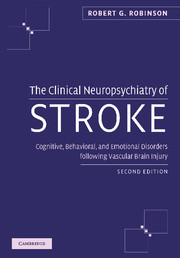 The Clinical Neuropsychiatry of Stroke
The Clinical Neuropsychiatry of Stroke Book contents
- Frontmatter
- Contents
- Preface
- Part I Introduction
- Part II Poststroke depression
- 5 Diagnosis of depression
- 6 Prevalence of depressive disorders
- 7 Phenomenology and specificity of depressive symptoms
- 8 Natural course of depression
- 9 Delayed-onset depression
- 10 Relationship to lesion location
- 11 Relationship of depression to cerebral dominance and structural asymmetries
- 12 Relationship of depression to bilateral hemisphere brain injury
- 13 Relationship of depression to physical impairment
- 14 Relationship to cognitive impairment and treatment
- 15 Relationship of aphasia to depression
- 16 Relationship of depression to social functioning
- 17 Relationship to premorbid risk factors
- 18 Mortality and treatment
- 19 Suicidal thoughts and plans
- 20 Biological markers
- 21 Mechanisms of poststroke depression
- 22 Treatment of poststroke depression
- 23 Prevention of poststroke depression
- Part III Poststroke mania
- Part IV Poststroke anxiety disorders
- Part V Other poststroke disorders
- Index
11 - Relationship of depression to cerebral dominance and structural asymmetries
from Part II - Poststroke depression
Published online by Cambridge University Press: 01 October 2009
- Frontmatter
- Contents
- Preface
- Part I Introduction
- Part II Poststroke depression
- 5 Diagnosis of depression
- 6 Prevalence of depressive disorders
- 7 Phenomenology and specificity of depressive symptoms
- 8 Natural course of depression
- 9 Delayed-onset depression
- 10 Relationship to lesion location
- 11 Relationship of depression to cerebral dominance and structural asymmetries
- 12 Relationship of depression to bilateral hemisphere brain injury
- 13 Relationship of depression to physical impairment
- 14 Relationship to cognitive impairment and treatment
- 15 Relationship of aphasia to depression
- 16 Relationship of depression to social functioning
- 17 Relationship to premorbid risk factors
- 18 Mortality and treatment
- 19 Suicidal thoughts and plans
- 20 Biological markers
- 21 Mechanisms of poststroke depression
- 22 Treatment of poststroke depression
- 23 Prevention of poststroke depression
- Part III Poststroke mania
- Part IV Poststroke anxiety disorders
- Part V Other poststroke disorders
- Index
Summary
Background
In Chapter 10, I discussed studies demonstrating an association during the acute stroke period between major depressive disorder and lesions of the left dorsolateral frontal cortex or left basal ganglia. Although there is a statistically significant increase in the frequency of major depression among patients with lesions of the left anterior brain region, not all patients with left frontal or left basal ganglia lesions develop depression. We therefore questioned whether patients who had a left anterior brain lesion without depression might have structural differences in their brains compared with those patients who developed depression after left frontal lesions. We have addressed this question in two different studies examining the effect of handedness and structural hemispheric asymmetry on the frequency and clinical correlates of depressive disorder.
Patients with left sided motor dominance
In the first study, a consecutive series of 30 patients who were left handed, without evidence of mixed motor cerebral dominance, was evaluated for depressive disorders (Robinson et al. 1985). Patients were included if they reported the predominant use of their left eye for vision, left hand for writing and eating, and left foot for kicking. Patients also had to have a single stroke lesion without a clinical history or computed tomography (CT) scan evidence of prior brain injury.
- Type
- Chapter
- Information
- The Clinical Neuropsychiatry of StrokeCognitive, Behavioral and Emotional Disorders following Vascular Brain Injury, pp. 111 - 119Publisher: Cambridge University PressPrint publication year: 2006


